|
There is nothing magic about free-energy and by “free-energy” I mean something which produces output energy without the need for using a fuel which you have to buy. Buoyancy While we are aware of buoyancy being used to convert wave power into electricity, we seem to neglect the idea of using the very powerful buoyancy forces as a direct tool at locations away from the sea. This is definitely a mistake because serious levels of power can be generated from such a system. One such system is: The “Hidro” Self-Powered Generator of James Kwok. This design demonstrates yet again, the practical nature of drawing large quantities of energy from the local environment. Commercial versions are offered in three standard sizes: 50 kilowatt, 250 kilowatt and 1 megawatt. This generator which James has designed can be seen at the Panacea-bocaf.org web site here and on James’ own web site here both of which have video clips explaining how the design works. The method is based on different pressures at different depths of water, gravity, and on the buoyancy of air-filled containers. The system does not rely on wind, weather, sunlight, fuel of any type, and it can operate all the time, day or night, without causing any kind of pollution or hazard. This particular design calls for a water-filled structure of some height, a source of compressed air and a pulley system, and without wishing to be in any way critical, it seems rather more complicated than it needs to be. If, unlike James, you have not done the mathematics for the system, you would assume that the amount of power generated by a system like this would be less than the amount of power needed to make it operate. However, that is definitely very far from reality as considerable excess power is gained through the natural forces of the local environment which make the system operate. Part of the patent application which James made is shown here: HYDRODYNAMIC ENERGY GENERATION SYSTEM 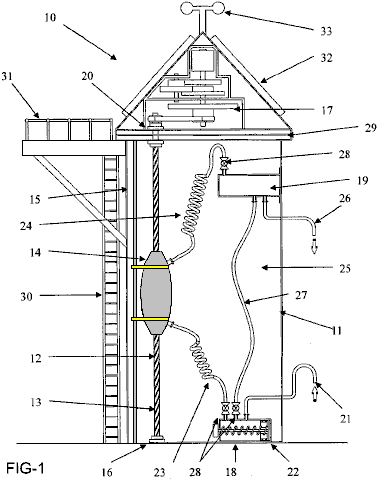 Fig.1 is a cross-sectional view of an embodiment of the energy generation system of the present invention. Here, the energy generation system 10 comprises a vessel 11 in the form of a water tank and a shaft 12 which can rotate about it’s longitudinal axis. The shaft 12 is provided with a helical screw groove 13 and is connected at it’s lower end to a bearing 16 which allows it to rotate freely about its longitudinal axis. The upper end of the shaft is connected to a generator 17 which is a flywheel system. The rotational energy of shaft 12 may be transferred to the generator through a ratchet-cog system 20. A buoyant inflatable capsule 14 is provided along with its guiding mechanism 15 which is in the form of a wire or pole to assist in the smooth vertical movement of buoy 14. There is a first air reservoir 18 located in a lower portion of the vessel 11 and a second air reservoir 19 located in an upper portion of the vessel 11. The first reservoir 18 draws air from the atmosphere, in through air intake port 21. Once the pressure in the first reservoir has reached a predetermined value, a piston 22 is actuated, forcing air through hose 23 into the buoyant capsule 14, which, when inflated, begins to move upwards through water tank 11, as the buoy 14 has become less dense than the fluid 25 (such as fresh water or saltwater) in tank 11. This in turn causes rotation of shaft 12, and activation of the power generator 17, thereby generating power. When buoy 14 reaches the upper limit of its travel, the air in the buoy may be forced to flow through a second hose 24 and into the second air reservoir 19. When air is removed from the buoy it moves downwards through vessel 11 under gravity and with the assistance of ballast (not shown). The downward movement of buoy 14, causes rotation of the shaft 12, which drives the generator 17, thereby generating power. Air stored in the second reservoir 19 may be vented to the atmosphere through a vent 26 if the pressure in the second reservoir 19 becomes too high. Alternatively, air may flow from the second reservoir 19 into the first reservoir 18 through a third hose 27 so that less air must be drawn into the first reservoir 18 when buoy 14 reaches the lower limit of its travel and must once again be inflated with air from the first reservoir 18. The hoses 23, 24 and 27 are provided with non-return valves 28 to ensure that air will flow in only one direction through the system 10. Vessel 11 may be provided with ventilation 29 as required and it may also be provided with access stairs 30 and an access platform 31 so that maintenance may be carried out as required. The system may also be provided with a solar energy collection device 32 to generate at least a portion of the energy required to drive piston 22 and the non-return valves 28. Energy produced by the solar energy collection device 32 may also be used to power a light or beacon 33 to indicate the location of the system 10. 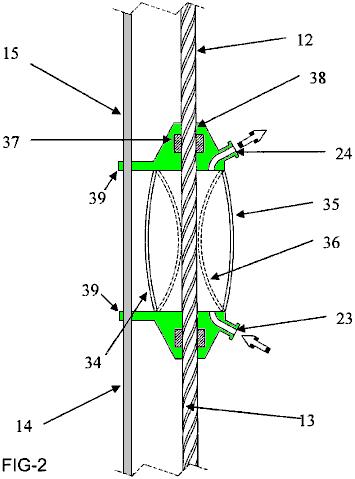 Fig.2 shows one arrangement for buoy 14 comprising an inflatable capsule 34. This figure illustrates the shape of the walls of the inflatable capsule 34 when inflated 35 and when deflated 36. Air passes into capsule 34 through hose 23 and exits from the capsule through hose 24. The buoy 14 also has a sleeve 37 attached to it. This sleeve has projections which engage with the helical groove 13 of shaft 12, thereby causing rotation of the shaft when the buoy moves relative to shaft 12. Sleeve 37 is provided with ballast 38, such as stainless steel weights that assist in the downward movement of the buoy when it is deflated. Buoy 14 is attached to a guide pole 15 and the buoy has a pair of arms 39 which slide on the guiding pole 15 and assist in the smooth vertical movement of the buoy. 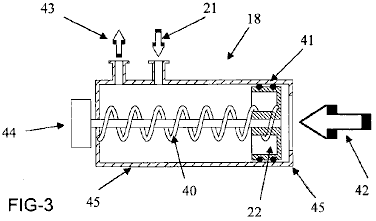 Fig.3 shows one version of the first air reservoir 18. Air is drawn into reservoir 18 through air intake 21. The reservoir includes a piston 22 associated with a spring 40, the piston 22 being provided with seals 41 to prevent leakage of air. When pressure, such as hydrostatic pressure, is applied in the direction of arrow 42, the piston moves to the left of the reservoir 18 compressing spring 40 and forcing air out through outlet 43. A motor 44 is provided to reverse the movement of the piston 22. Reservoir 18 may be fixed to the floor of the vessel. 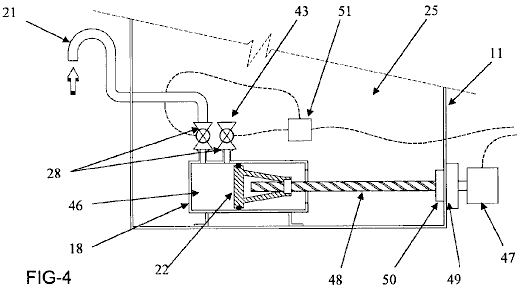 An alternative construction of the first air reservoir 18 is shown in Fig.4. In this embodiment, reservoir 18 is housed within a vessel 11 containing a fluid 25. Air enters reservoir 18 through air intake 21 and is held in a chamber 46. The reservoir has a piston 22 and the movement of the piston 22 towards the left of the reservoir 18 forces air in the chamber 46 out through air outlet 43. Piston 22 is driven by motor 47 which rotates the helically-grooved shaft 48. The motor is linked to the shaft by a ratchet and cog mechanism 49, which is provided with a spring loaded seal 50 on the inner surface of vessel 11. An actuator 51, may be used to control the opening and closing of non-return valves 28 as well as the actuation of motor 47. Fig.5 illustrates a cross-sectional view of an energy generation system according to one of the embodiments of the present invention: 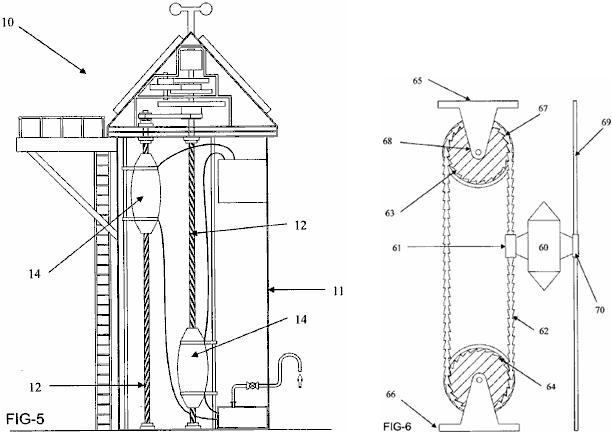 Fig.5 shows an embodiment where which a pair of buoys 14 are present. Each buoy is associated with its own shaft 12 and may move up and down inside vessel 11 independent of one another. In Fig.6, an alternative embodiment of the present invention is illustrated, where the buoy 60 has a connecting method 61 in the form of a cylindrical sleeve through which a guide chain 62 passes. Chain 62 is provided in an endless loop and is located on an upper tracking device 63 and a lower tracking device 64, both of which are pulleys. The upper pulley 63 may be fixed to an upper wall (not shown) of a vessel (not shown) via a bracket 65, while the lower pulley 64 may be fixed to a lower wall (not shown) of a vessel (not shown) via a bracket 66. The connection mechanism 61 contains ratchets which engage with the links of the chain 62 when buoy 60 moves downwards. Thus, as buoy 60 moves downwards, chain 62 also moves, thereby causing both the upper and lower pulleys to rotate in a clockwise direction. The upper and lower 64 pulleys have a series of indentations 67 corresponding to the shape of the links of the chain 62. In this way, the chain 62 sits in the indentations 67 and grips the tracking device (63, 64), thereby ensuring that the tracking device (63, 64) rotates. In the embodiment of the invention illustrated in Fig.6, a work shaft 68 is associated with the upper pulley 63 such that rotation of the upper pulley results in rotation of the work shaft 68. The work shaft 68 is located substantially perpendicular to the direction of travel of the buoy 60. The work shaft drives a generator to produce power. 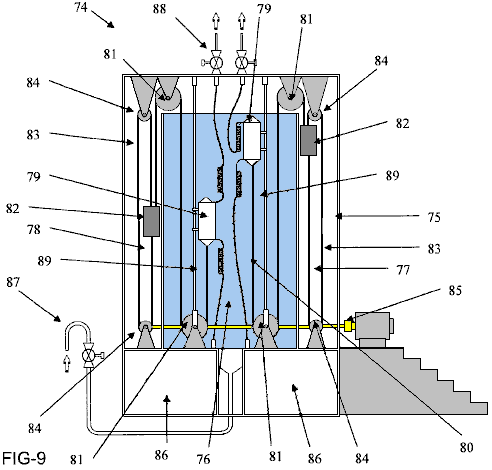 Fig.9 shows an alternative embodiment of this energy generation system 74. The system is comprised of a vessel 75 having a fluid-filled “wet” compartment 76 and one or more “dry” compartments (in this case, a pair of dry compartments 77, 78) with no liquid in them. These dry compartments may be fabricated from any suitable material, such as, concrete, steel, fibreglass, plastic or any combination of materials. The system also has a pair of buoys 79 each with a deflatable bladder-like construction. The buoys have guide rails 89 which ensure that the buoys move smoothly up and down inside the vessel 75. In this embodiment of the invention, air reservoirs 86 are located in the base of the vessel 75. Air enters the reservoirs 86 through inlet 87, while air exiting from the buoy 79 is vented through valves 88. The vented air may either be expelled to the atmosphere or recycled to the reservoirs 86. Each of the buoys is designed to be connected to one end of a chain or rope 80. A weight 82 is connected to the other end of the chain or rope 80. The chain or rope 80 has a series of pulleys 81 such that when the buoy is inflated and filled with air, the buoyancy is greater than the weight 82 and so the buoy rises in the vessel. When the buoy 79 is deflated, weight 82 is heavier than the buoyancy and so the buoy sinks in vessel 75. In the embodiment illustrated here, the weights 82 are located in the dry compartments 77,78. There are several reasons for this, including that, by locating the weights 82 in the dry compartments 77,78, the velocity of the weights 82 in the downward direction is increased, and therefore an increase in the energy produced by the system 74 is experienced. The weights 82 are associated with second ropes or chains 83, such that vertical movement of the weights 82 results in the rotation of the second ropes or chains 83 around a pair of sprockets 84. Rotational energy generated by the rotation of the second ropes or chains 83 is transferred to a power generation device 85 (such as a turbine or the like) in order to generate power (e.g. electrical power) In spite of its mechanical complexity, the Hidro design is offered as a commercial generator with tens of kilowatts of excess power, indicating that buoyancy is a significant method of generating power, based on the fact that water is hundreds of times heavier than air. Due to its weight, movement in water is slow but can be very powerful. The helical groove method of converting the vertical movement of the floats into rotational power is used because of this as it has a very high ratio between shaft turns and movement along the shaft. This can be understood when you consider the fact that a complete revolution of the shaft is caused by the float moving up just one step to the next thread position directly above. The turns ratio for the complete float movement is determined by the angle of the groove cut into the drive shaft. One other thing which needs to be considered for such a project is the weight of the overall structure when filled with water. The overall weight is liable to be many tons and so the footing underneath the generator needs to be very robust. Also, while compressed air is mentioned, giving the impression of cylinders of compressed air or gas, For continuous operation one would expect an air pump to be used. Whether or not an air pump is used, the diameter of the air hoses needs to be considered. Most people think that a gas can flow along a pipe or tube very easily. That is not the case. If you want to get a feel for the constriction caused by a pipe, then take a one metre length of 6 mm diameter plastic tube and try blowing through it. No significant amount of air will pass through the tube even if you blow very hard. The web site www.engineeringtoolbox.com shows this table: 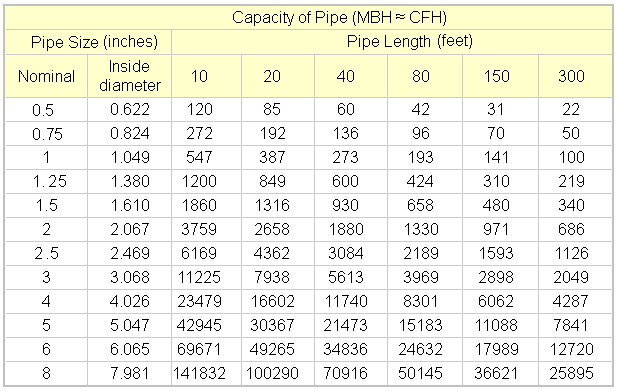 Notice the major difference in carrying capacity of any of these pipes with just the change from a 10-foot (3 metre) length to a modest 20-foot (6 Metre) length, and those lengths are the sort of lengths needed for many applications. Also, look at the figures for, say, the 0.5 inch (nominal) diameter pipe. With just a 10-foot length, it would take a full two minutes to pump just one cubic foot of air through it. It follows then, that pipes of considerably larger diameter are needed for a project like the ‘Hidro’. It is possible to construct a much more simple version of the ‘Hidro’, perhaps like this: A Simple Buoyancy Power Generator A simple hydraulic, buoyancy-powered generator can be constructed, with two or more horizontal, rotating shafts submerged in water in such a way that they are effectively positioned one above the other. Each shaft has one, and preferably two or more sprocket wheels mounted on it. Each of these sprocket wheels engages with a continuous chain loop which also engages with the sprocket wheel which is positioned vertically above it. These vertical chain loops form a belt-style support for a series of identical buckets. On one side of the vertical belt the buckets have their open face upwards and on the other side the bucket openings are facing downwards. An air pump is positioned directly underneath the set of buckets which have the bucket openings facing downwards. The air pump generates an upward-moving stream of air which collects in the rising buckets, displacing the water filling the bucket. This results in a powerful upward thrust caused by the buoyancy of that bucket, and the thrust causes the bucket to move upwards, rotating both horizontal shafts and bringing another water-filled bucket into position above the air pump. A gearing system transfers the rotation torque thus produced, to a generator which produces electricity for general purpose uses. This is a generator whose input shaft is rotated through buoyancy caused by air-filled containers submerged in a tank of water or some other suitable heavy liquid. Continuous, powerful rotation of the generator shaft is produced through the use of one or more conventional, commercially available air pumps. An air pump is used to fill a series of containers which are open at one end and which are attached to what is effectively a belt arrangement created by two strong chain-link loops which mesh with sprocket wheels mounted on two shafts, either, or both of which can be utilised for the extraction of useful power, preferably for driving an electricity generator but not necessarily limited to that function as any powerful torque has many useful applications. Objectives are to provide a power generation system which is very simple in form and which can be understood, operated and maintained by people with minimal training. Also, a system which uses components which are already readily available, thus avoiding significant manufacturing costs, and one which operates without the need for any kind of complex mechanism or high-precision equipment and which can operate with a wide range of commercially available products. 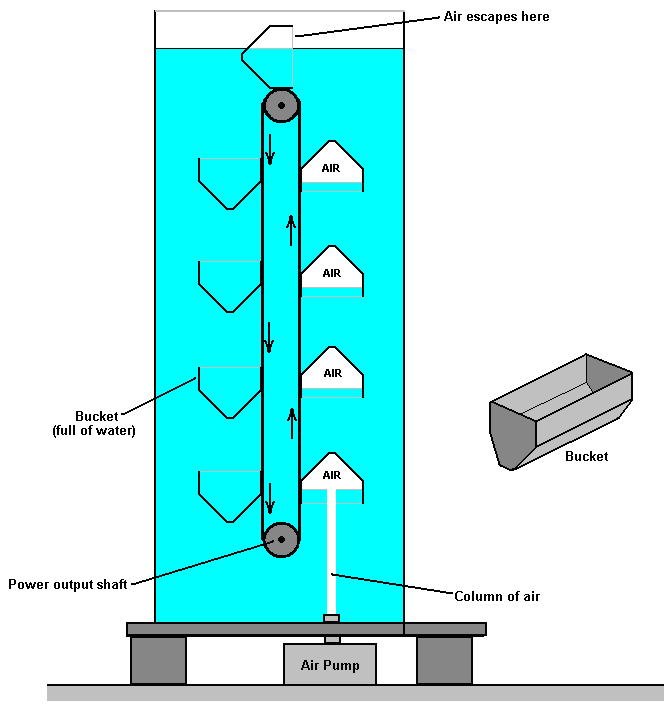 Fig.1, is a simplified partial schematic cross-sectional view showing the main components of the generator as seen from one end. 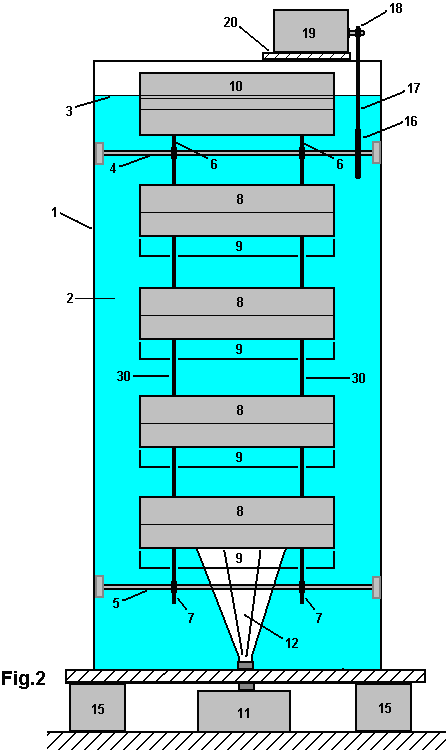 Fig.2, is a cross-sectional conceptual schematic view showing the front view of the generator in its most simple form. 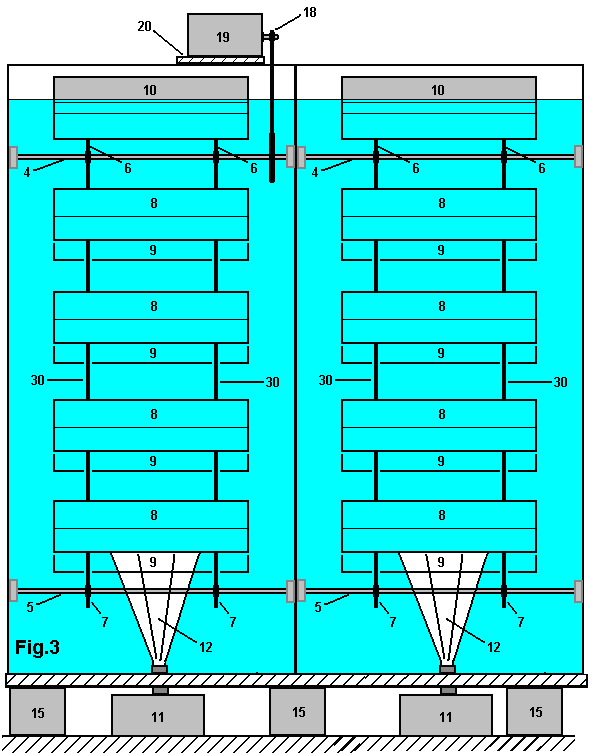 Fig.3, is a cross-sectional conceptual schematic view showing the front view of the generator where more than one set of buckets is used. 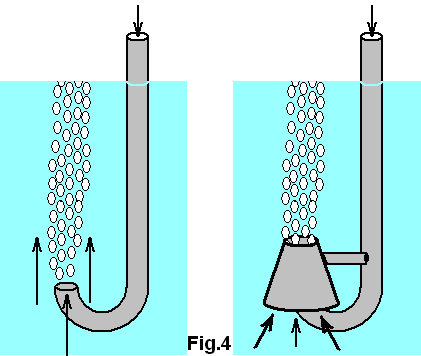 Fig.4, is a perspective conceptual view showing arrangements for a simplified air-feed system which operates from above the tank. Fig.1, illustrates the overall concept of the generator in its most simple form where lightweight rigid buckets are used to capture the rising air from the air pump. In this Figure, a water tank 1, holds water or other suitable liquid 2. The surface of the liquid 3, is indicated to illustrate the fact that a bucket 10, which is in the process of turning over at the top of its orbital motion, is positioned so that one edge of the bucket is clear of the surface of the water, which allows the air which was trapped inside the bucket to escape into the atmosphere and the water fill the entire bucket causing only a very minor turbulence when doing so. This is a desirable, but not essential feature as the air trapped in any bucket will escape upwards as soon as the bucket starts its downward movement, positioning its open end upwards, although this causes unnecessary turbulence inside the tank. One possible bucket shape is shown in perspective view, but many different bucket shapes may be used, including flexible membrane types or alternatively, hinged-plate types which have very much reduced resistance to moving through the water when in their collapsed state during their downward movement. The buckets 8, 9 and 10, are attached to two strong chains 30, which mesh with the upper sprocket wheel 6, mounted on the upper axle 4, and the lower sprocket wheel 7, which is mounted on the lower axle 5. Although it is not visible in Fig.1, there are two upper sprocket wheels 6, two lower sprocket wheels 7, and two chain loops 30, although these can be seen in Fig.2. The tank is supported on a robust plate 14, which itself is supported by a series of pillars 15 which rest on a secure footing 16, providing operating space underneath the tank for the installation and maintenance of the air pumping equipment. As fresh water weighs 1000 Kg per cubic metre, the weight of the operational generator system is substantial and so this must be allowed for when assessing the footing needed to support the tank and it’s contents. While a thin-wall tank is shown in Fig.1, many different forms of tank may be utilised, including earth bank and plastic membrane styles, or resurfaced abandoned well shafts. The tank of Fig.1 presumes that the lower axle 5 is taken out through the wall of tank 1, using an arrangement similar to that used for the drive shafts which power the screws of ships and other power vessels. While an arrangement of that type provides a drive shaft which is conveniently close to the ground, the much more simple arrangement shown in Fig.2 where the output power is taken off using the very simple chain and sprocket wheel method utilised for the bucket supports (chain 30, and sprocket wheels 6 and 7). In general, the more simple and straightforward any design is, the better it works in practice and the lower any maintenance costs become. Referring again to Fig.1, when activated, air pump 11 produces a stream of air 12, which flows rapidly upwards. This stream of air 12, once established, does not have to push against the head of water as immediately above the nozzle of the pump is a rapidly rising column of air, sustained both by the exit velocity from pump 11 and the natural upward movement caused by the relative weights of water and air (as water is several hundred times heavier than air). This column of air would normally flow straight upwards in calm water, but should it be found that turbulence in the water tends to push the rising air away from its vertical path, baffles can be placed around the pump and positioned so that the air stream is forced to stay within the same section of water taken up by the rising buckets. The rising air enters the lowest of the rising buckets and collects in it, forcing the water out of the open bottom of the bucket. If the rising bucket is not completely filled with air before the next bucket moves between it and the air pump, the trapped air will expand as the bucket rises and the water pressure reduces due to the lesser depth. Any one bucket with a substantial amount of air in it will create a very significant upward force due to buoyancy, air being about one thousand times lighter than water. Each bucket on the rising side adds to that upward force and consequently, the chains 30 need considerable strength. The weight of the buckets on each side of the chain match and so the main advantage of light buckets is to lower the inertial mass of the moving parts. Movement through the water is relatively slow but this is offset by gearing between the output drive shaft and the generator’s input shaft. The power of the system can be increased by adding more buckets in the vertical chain, increasing the water depth accordingly. Other ways of increasing the power include increasing the volume inside each bucket and/or increasing the flow rate produced by the air pump or pumps used. Another simple method is shown in Fig.3 and discussed below. An alternative to air pumps is to use tanks of a compressed, non-polluting gas, possibly air. The buckets shown in the various Figures are rigid, very simple shapes, possibly made by a plastic moulding process in order to be cheap, strong, lightweight and permanently water-resistant. There are, of course, many possible variations on this including using rigid hinged plates sealed with a strong flexible membrane, allowing the buckets to fold and become streamlined on their downward path, and opening as soon as they turn to start their upward movement. There are many mechanisms which can provide this movement, but it is a matter of opinion as to whether or not the extreme simplicity of rigid buckets is worth sacrificing Fig.2 shows a schematic layout of the generator when seen from the side. The same numbers apply to the components already seen in Fig.1. The arrangement seen in Fig.2 is the most simple, basic, single bucket set. The near-side rising buckets 8 obscure the view of the far-side falling buckets 9 and only the lowest part of the falling buckets 9 can be seen in this view. Fig.1 shows buckets which are some two and a half times longer than they are wide, but this, of course, is just one option among literally thousands of possible proportions. The size and shape of buckets is related to the performance and number of air pumps being used for any one set of buckets and that choice depends on what is available locally at a reasonable price. It would not be unusual for two or three air pumps to be used side by side along the length of the bucket 8 although Fig.2 only shows a single pump. Fig.2 also shows a simple method for power take off where a large diameter sprocket wheel 16 is mounted on the upper axle 4, and driving a much smaller diameter sprocket wheel 18 which is mounted on the drive shaft of the electricity generator 19 which is mounted on plate 20 which is attached securely to the top of tank 1. Fig.3 shows one of the possible arrangements for increasing the system power without increasing the depth of water used. Here, the axles 4 and 5 extend far enough to allow another set of buckets to drive them, increasing the torque very substantially. While Fig.3 shows one extra set of buckets, there is, of course, no reason why there should not be three or more sets of buckets side by side. It should be noted however, that the partitions shown between the bucket sets are not there just to reduce the water swirling but are needed to support the bearings which are essential for the extended axles, since without those, the diameter of the bars used for the axles would have to increase very markedly to avoid unwanted flexing along their length. While the second set of buckets has been shown aligned exactly with the first set, there is an advantage in offsetting them relative to each other so that the output torque is more even with buckets emptying and filling at different points in the bucket cycle. Fig.4. shows a method for further simplification, where the air is pumped from above the water surface. It is a matter of concern to most people, that the pressure of the head of water above the air pump is a major obstacle to overcome and will be a continuous opposing force during operation of the generator. If air is being injected from underneath the tank, then initially, that pressure head has to be overcome. However, once the air flow is established, a vertical cigar-shaped area of water vortex is established by the rising air stream. This three-dimensional annular vortex negates the water head in the small area immediately above the air nozzle, and almost sucks the air out of the pump, after the initial introduction of the air has been accomplished. There is another way of achieving this desirable effect without ever having to pump against the total head of water, and that is to use a mobile air pipe as shown in Fig.4. Initially, the air pump is started and lowered a short distance into the water. The opposing head of water is not large and the water vortex can be established quite easily. The pipe is then lowered very slowly, so as to maintain the vortex at a progressively lower depth, where, in spite of the increased head of water, the pump does not have to overcome that head. When the pipe outlet reaches the operational depth, it is then rotated to bring it under the set of rising buckets. The major advantage of this arrangement is that the tank is as simple as possible, with no possibility of leaking, and so abandoned wells can be modified to become energy generators. Alternatively, an earth bank can be erected to form an above-ground tank, possibly sealed with a plastic membrane. This method also avoids needing to support the weight of tank and water above a work-area where the air pump or compressed-air cylinders are located and maintained. The creation of the water vortex can be assisted by the addition of a cowl around the pipe exit as shown in this figure, but that is an optional feature. Patrick Kelly http://www.free-energy-info.com http://www.free-energy-devices.com http://www.free-energy-info.tuks.nl |